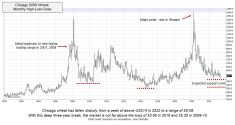Ontario corn prices appear to be consolidating. Export demand for Ontario has been minimal over the past month; therefore, the domestic prices have been based on local feed values. Ethanol producers appear to have sufficient coverage for nearby positions.
Soybean exports continue to exceed expectations while demand from the domestic crush was driven by stronger meal values. Soybean stocks in commercial positions are tightening. Soft red winter wheat prices started to trend higher during the first week of February. Farmers only sell about 60,000 tonnes of wheat per month from January through March and the lack of farmer selling has resulted in firmer prices. The domestic wheat market is based on world values with domestic millers covered through spring.
Quick look
Soybeans: The market needs to encourage acreage this spring, as stocks are at historically tight levels.
Corn: A seasonal rally is brewing for March and April.
Wheat: Yield prospects have improved for U.S. winter wheat.
Read Also

High oleic soybeans can be a fat replacement in dairy rations
The potential for feeding high oleic soybeans to dairy cows opened up a new market for Ontario’s Sevita soybean seed company.
Argentine farmers are in the final stages of planting corn and soybeans. Recent rains have enhanced yield prospects. Brazilian farmers had harvested approximately eight per cent of the soybeans as of Feb. 5, down from an average of 15 per cent. The planting of the second corn crop is in the early stages and lagging at year-ago levels due to the slower soybean harvest pace.
The U.S. corn market is being supported by increased export demand amidst a tight fundamental structure. Offers out of the Gulf are more competitive than Brazilian origin for March through May. Both U.S. corn and soybean markets need to encourage acreage this spring.
The wheat market is focused on developments in the Russian Ukraine war. It appears that Russia is gearing up for a major offensive. Ukraine wheat, corn and barley production will be down sharply from year-ago levels. Exports from the Black Sea region could come to a standstill later in April which would result in a sharp rally in the wheat complex. The wheat market will be sensitive to Northern Hemisphere conditions as the market cannot afford a crop problem in any major producing country.
Since early January, the March Canadian dollar has traded in a range with support at 74 U.S. cents and resistance at 75.50 U.S. cents. The U.S. Federal Reserve appears to be more hawkish than the Bank of Canada moving forward. The U.S. economy is expected to experience a minor recession in the latter half of 2023 while the Canadian economy will likely tread water showing marginal growth. We have a neutral outlook for the Canadian dollar for the second quarter of 2023. Geopolitical events will continue to influence grain and oilseed price direction.
Soybeans
Canadian year-to-date soybean exports for the week ending Jan. 29 were 2.9 million tonnes, up 300,000 tonnes from last year. Domestic usage was one million tonnes, unchanged from year-ago levels. Keep in mind the 2022 Ontario soybean harvest was four million tonnes, down 100,000 tonnes from last year. The market is contending with lower supplies and a year-over-year increase in demand.
Moving forward, the domestic market will maintain a premium over world values to slow offshore movement. The Ontario market also needs to encourage imports from the U.S. during May through July. Commercial stocks in Ontario continue to tighten and the market also needs to pull stocks from farmers. Ontario soybean stocks at the end of the 2022-23 crop year will be historically tight. The market needs to encourage acreage this spring.
As of Feb. 6, soybean offers from Brazil were US$575/tonne, unchanged from 14 days earlier. U.S. offers f.o.b. the Gulf were up US$10/tonne from late January at US$610/tonne. Brazilian offers will become more aggressive as the harvest progresses.
Recent rains have delayed harvest progress in Brazil but yield reports continue to come in better than expected. The crop is expected to finish in the range of 156 to 160 million tonnes, up from the USDA estimate of 153 million tonnes and up from 129.5 million tonnes last year. There is no change to Argentine estimates which range from 44 to 46 million tonnes, relatively unchanged from the year-ago output of 44 million tonnes. Argentina is the world’s largest meal exporter. The dryness in Argentina is causing strength in the meal market and sustaining strong crush margins in North America.
What to do: Like Ontario, U.S. soybean stocks will be historically tight at the end of the 2022-23 crop year. The market will have a significant acreage battle this spring with corn and to a certain extent spring wheat. We’ve advised farmers to be 80 per cent sold on their soybeans. Barring adverse weather forecasts, we plan to make the final sale in April.
Corn
Ontario corn exports during January were disappointing. Unofficial data has exports at 70,000 tonnes. Exports will remain in the doldrums until March at which time we expect stronger demand from Northern Europe. Commercial companies appear to be saturating domestic demand. Feedlot operators have the bulk of their spring requirements covered.
Ethanol processing margins have been struggling, resulting in lower usage. The current demand environment has caused corn prices to trade in a sideways range over the past month. Looking forward, the market is poised for a seasonal rally in late March and April.
U.S. offers f.o.b. the Gulf were hovering at US$305/tonne while Brazilian origin corn was quoted at US$310/tonne f.o.b. Paranagua. French corn was quoted at US$310/tonne f.o.b. La Pallice. We’re expecting a rally in the French corn market over the next month at which time Ontario corn will be able to trade into Northern European destinations. There is also a weather/ice premium for vessels coming into the St. Lawrence River resulting in higher freight rates in the short term.
Earlier in February, the first Brazilian corn vessel arrived in China. China and Brazil agreed on phytosanitary conditions last spring allowing shipments from Brazil. China has given the U.S. the cold shoulder on corn. Political tensions have contributed to the lack of Chinese demand for U.S. corn.
The corn market has three main factors brewing that will spark a major spring rally. The U.S. corn carryout for 2022-23 is projected to come in at 31.5 million tonnes, down from the five-year average of 45.2 million tonnes. The U.S. corn market needs to encourage a year-over-year acreage increase of three to four million acres.
Secondly, Ukrainian corn production will experience a sharp decrease this year. Ukrainian exports will be minimal in the 2023-24 crop year. And finally, Brazil’s second major corn crop is being planted later than normal. The crop will go through pollination during the major heat in May. There is a fair amount of uncertainty with the Brazilian crop.
What to do: We have advised producers to be 50 per cent sold on corn. We are planning our next sale in April and then in May.
Wheat
The Ontario wheat market has been relatively quiet throughout January and February, which is normal. Export demand has been quiet and domestic millers have sufficient ownership for the time being. Ontario farmer selling experienced a minor surge in January. Looking forward, we are anticipating a major rally in March.
An extension to the Black Sea Grain Initiative will need to be negotiated in late March. Russia is planning a major offensive in the latter half of February. Ukrainian forces are receiving support from the West. There is potential for all hell to break lose in this region. This is bullish wheat. The 2022 Russian wheat crop was estimated at 100 to 105 million tonnes; early estimates have the 2023 Russian wheat crop in the range of 80 to 85 million tonnes. The Ukraine wheat crop is uncertain. The exportable surplus will be minimal in 2023-24.
The main wheat growing area of China received less than 25 per cent of normal precipitation during December. Minimal precipitation has materialized in January. China is going into spring planting for corn and soybeans under very dry conditions. This is a major risk for the 2023 growing season because China is on the verge of another drought. U.S. and Chinese political tensions are also coming into play.
Yield prospects have improved for U.S. hard red winter wheat after timely precipitation earlier in winter. The crop remains vulnerable to winter kill and dry conditions. Timely rains will be needed in the Southern Plains during April. U.S. hard red spring wheat stocks will be historically tight at the end of the 2022-23 crop year. The hard red spring market needs to encourage acreage in North Dakota and Minnesota. The tighter fundamental structure south of the border put more emphasis on Western Canada this spring to satisfy any shortfall in production.
Europe appears to be in good shape so far. Normal precipitation has occurred over the winter in major growing regions including France and Germany. The harvest pressure from Australia appears to be subsiding after farmers harvested their third bumper crop in a row. Argentina won’t be a major player in the wheat market after the drought cut their production.
What to do: We’re 40 per cent sold on the wheat. Ontario stocks will tighten during the spring causing basis appreciation. The world market tends to incorporate a risk premium when the northern hemisphere wheat comes out of dormancy. This risk premium will be enhanced this year due to the war in Ukraine and tight stocks in North America. The wheat market will be extremely sensitive to precipitation forecasts for the Southern Plains.
















